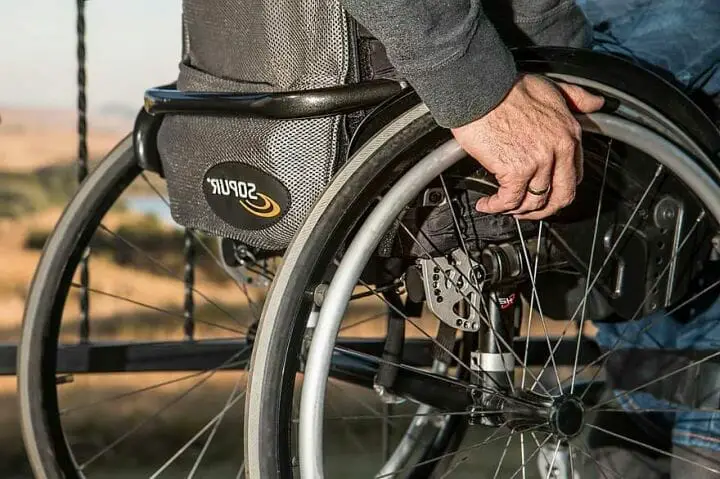Your wheelchair, be it a manual or a battery-operated one, gives you great freedom in your everyday life, giving access to most of the public places like malls, theatres, beaches, parks, banks, and so on.
A good wheelchair can transform the lives of people with limited or no mobility, and in turn uplift the lives of their near and dear ones.
A challenge you’ll face almost every day when you’re going around with your wheelchair and possibly even in your own home is how to go up a ramp. In the majority of buildings, you may need to go up one or more ramps to reach the inside of the building.
Most of these ramps may be quite easy to maneuver, but some of them are quite steep and will always require a caregiver or companion to assist you up. In this article, we discuss the various ways of pushing a wheelchair up a steep ramp and the safety measures to adopt.
Contents
Basics of the Wheelchair Ramp and Things to Consider
As we’ve mentioned above, wheelchair ramps offer users freedom if constructed properly. They provide access to buildings and other locations where there are stairs or an obstacle that you have to get across.
But some wheelchair ramps are too steep, hence, difficult to use or sometimes can even be dangerous. As per the Americans with Disabilities Act (ADA), the slope of the wheelchair ramp is to be is 1:12.
It means that for every 1-foot height the wheelchair needs to be taken up, the ramp must be at least 12 feet long, if not more. This translates to roughly an 8 percent gradient.
On the face, this may not appear very steep, but you still need to take certain steps and approaches to safely push a wheelchair up a ramp.
There are two types of wheelchair ramps that vary basing on your need.
- Permanent or semi-permanent wheelchair ramps (typically for access to buildings or public area)
- Portable wheelchair ramps (typically for access to small obstacles like doorway thresholds)
While the maximum allowed slope is 1:12, practically 1:18 gradient is recommended for the elderly users. Even that might seem steep for certain users. In icy or wet climates, it is recommended to have wheelchair ramps that are less to avoid slipping.
In the sections below, we discuss how you should prepare before pushing a wheelchair up a ramp, and additional safety tips that should be followed to avoid any possibility of injury to either the wheelchair user or caregiver pushing the chair.
Preparing the Wheelchair Beforehand
There are some preparations and precautions that should be taken before pushing the wheelchair up a ramp, which would make the activity easier and safer.
Anti-Tippers:
The most important thing that you need to have in your wheelchair is anti-tippers. They are primarily used to avoid the falling over of the wheelchair backward while you are seated on the chair.
This device includes 2 tiny wheels and 2 arms that are connected to the back of the chair exactly below its rear wheels.
Some chairs come with standard anti-tippers fitted, while with other chairs you can add the anti-tippers by ordering them separately. While choosing your wheelchair, it is better to buy one that comes preinstalled with anti-tippers.
When using a wheelchair ramp, anti-tippers are essential to prevent it from tipping over.
You may also like How to Get a Wheelchair Up and Down Stairs
Weight Reduction:
Before starting to push the wheelchair up a steep ramp, remove unnecessary items and accessories from the wheelchair to make it easier for the companion to push it up. For example, remove your bags, water bottle, umbrella, and any other such item from the wheelchair and carry them separately.
Ideally, the companion should have to push up only the combined weight of the wheelchair and the person in it.
Manual Mode:
If you’re using a power wheelchair, please remember to put it in Manual mode before starting the operation. Otherwise, sudden powering on of the wheelchair may result in a mishap and cause serious injuries for both the user and the caregiver.
Seat Belt:
You should always fasten the wheelchair seat belt on the user securely before pushing them up a steep ramp. It will ensure that there is no possibility of the user falling out of the chair and getting injured.
You may also like Best Wheelchair Headrests
Pushing a Wheelchair up a Steep Ramp
Once you’ve taken all the precautions and made preparations as above, follow the approach detailed below to push the wheelchair with the user up a ramp.
- As explained above, you need to have your wheelchair equipped with anti-tippers and put them down when ascending a wheelchair ramp. They will be located on the back of the wheelchair and have either a pad or tiny wheels. This will help in preventing backward tipping.
- Before starting to push the wheelchair up the ramp, lean slowly into the ramp’s slope. It will significantly help you keep your balance and also push the wheelchair with your maximum power as you move up the ramp.
- Before starting the ascent up the ramp, talk to the wheelchair user to provide them comfort, and discuss the plan with them. Once you start to push it up, keep conversing constantly with the person in the wheelchair. Always make sure to let them know if you’re having trouble and need to take a break. At any point during the ascent if you need to stop, place the wheelchair perpendicular to the slope of the ramp so that the possibility of it rolling down is minimal.
- The wheelchair user should also lean forward along with the person pushing the chair up the ramp so that more force can be applied. The need for forward lean increases as the slope becomes steeper. If possible, lean forward a little more with each push to apply greater forces to the wheelchair.
- If the incline is too steep, push the wheelchair in a zigzag pattern to make it easier for you to move it up, making sure not to hit the rails if there are any on either side.
- Always derive strength from your legs rather than your back to push the wheelchair up. Keep your back in a straight position all the time and be careful about your body to avoid future back injuries from pushing a chair incorrectly.
- If you feel tired, try to turn the wheelchair to the side and rest for some time. This can be done without turning on the locks on the wheels. Though it seems counter-intuitive, occupier chair stability is low when you apply locks on wheels compared to when they’re not.
Safety Tips – Pushing a Wheelchair up a Ramp
Landings:
It is absolutely necessary to have flat surfaces or level landings both at the bottom and top of the wheelchair ramp. A landing at the top of the ramp facilitates either user or the caregiver to open the door easily at the top of the wheelchair ramp.
In case of no level landing at the top, it becomes very difficult and sometimes impossible to open the door. On the other hand, a landing at the bottom of the ramp is important to bring the wheelchair to a halt before taking a turn.
If the length of the ramp is substantially long, it is required to include one or more level resting platforms in the middle of the ramp to help the caregiver and user take a break if they get tired.
Transition to Landing:
Generally, it is important to keep a gradual transition from the wheelchair ramp to the landing. This is more critical at the bottom than at the top of the ramp. Wheelchairs are designed in a way that most of the weight is on the rear wheels.
Without a transition at the bottom of the ramp, the wheelchair can come to a sudden stop and cause an accident. A ramp with no transition to landing at the bottom of the ramp may be raised a little from the ground and can be a barrier for the wheelchair user or even a possible hazard for the caregiver.
You may also like Most Comfortable Wheelchairs
Weight specifications:
Weight specifications of different wheelchair ramps may be different as some ramps are designed for manual, power, and unoccupied wheelchairs.
Typically, wheelchair ramps should have a minimum carrying capacity of at least 550 lbs or 250 kg that will cover the weight of both the chair and the user sitting on it.
But make sure that the ramp you’re going to use has a minimum capacity that is more than the combined weight of you and your wheelchair.
Handrails:
If the wheelchair ramp is for the private use of only one person, that person can decide if they are likely to need handrails. But if the ramp is for the general public, handrails must be there on the ramp.
Handrails that can you can reach using two hands giving an option for users to put some force to help their companion or to take rest if they get tired or feel insecure.
The position of the handrails are also very important, as pediatric users will usually have a lower seat height than adult users. Hence two sets of handrails may be required for public ramps to help both sets of users. If the handrails are made from wood, they need to be finished carefully to avoid any injury from splinters.
Edge protection:
It is imperative to check before using a wheelchair ramp that it has raised edges on both sides to keep users from falling off. Different users may prefer different heights for the edge, but you should make sure that the wheelchair ramp has a good-sized edge protector before using it.
The edge protectors of track-type ramps make a ‘U’ shape that the wheels of the wheelchair may fit into, thereby forming a ‘gutter’. If track ramps have too narrow gutters, they may not allow the wheelchair casters (front wheel) to move freely and a caster may get stuck if it turns sharply in a sudden movement.
The gutter always needs to be larger than the diameter of the caster and the edge protectors also need to be high enough to prevent the wheel from going over.
You may also like Best Wheelchair Carriers
Conclusion
It is recommended that you try to get help from a caregiver or companion to push you up a steep ramp to avoid accidents.
If you’re the caregiver, always place yourself between the wheelchair and the bottom of the ramp. That way, even if by any chance you lose control of the wheelchair, you are still in place on the other end to protect the person in the wheelchair.



